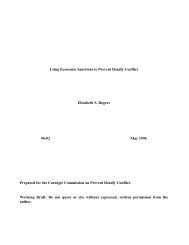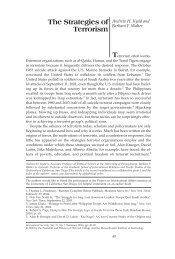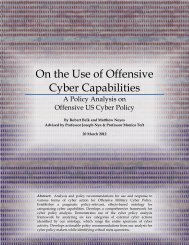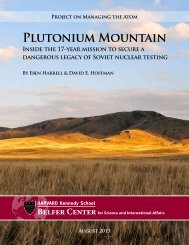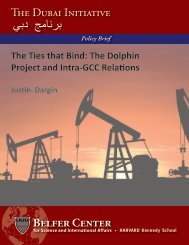AB 32 and Climate Change: The National Context of State Policies ...
AB 32 and Climate Change: The National Context of State Policies ...
AB 32 and Climate Change: The National Context of State Policies ...
You also want an ePaper? Increase the reach of your titles
YUMPU automatically turns print PDFs into web optimized ePapers that Google loves.
creases in the other states. <strong>The</strong> result would be 100 percent leakage, no gain in environmental protectionfrom the green state’s added activity, <strong>and</strong> a national loss <strong>of</strong> cost-effectiveness.Potential examples <strong>of</strong> this—depending upon the details <strong>of</strong> the regulations—include: first, <strong>AB</strong> <strong>32</strong> cap<strong>and</strong>-tradecombined with some U.S. Clean Air Act performance st<strong>and</strong>ards (neither H.R. 2454 nor anythinglike it are any longer on the table); second, state limits on GHGs/mile combined with federal CorporateAverage Fuel Economy (CAFE) st<strong>and</strong>ards; <strong>and</strong> third, state renewable fuels st<strong>and</strong>ards (RFS) combinedwith a federal renewable fuels st<strong>and</strong>ard or state renewable portfolio st<strong>and</strong>ards (RPS) combined with afederal RPS. A partial solution would be for these federal programs to allow states to opt out <strong>of</strong> the federalpolicy if they had an equally or more stringent state policy. Such a partial solution would not, however,be cost-effective.Benign InteractionsOne example <strong>of</strong> benign interactions <strong>of</strong> state <strong>and</strong> federal climate policy is the case <strong>of</strong> the RGGI in theNortheast. In this case, the state policies are less stringent than an assumed federal policy (such as H.R.2454). <strong>The</strong> result is that the state policies become nonbinding <strong>and</strong> hence largely irrelevant.A second example—that warms the hearts <strong>of</strong> economists, but appears to be politically irrelevant forthe time being—is the case <strong>of</strong> a federal policy that sets price, not quantity, i.e., a carbon tax or a bindingsafety valve or a price collar in a cap-<strong>and</strong>-trade system. In this case, more stringent actions in green statesdo not lead to <strong>of</strong>fsetting emissions in other states induced by a changing carbon price. It should be noted,however, that there will be different marginal abatement costs across states, <strong>and</strong> so aggregate reductionswould not be achieved cost-effectively.Positive InteractionsThree scenarios suggest the possibility <strong>of</strong> positive interactions <strong>of</strong> state <strong>and</strong> federal climate policies.First, states can—in principle—address market failures not addressed by a federal carbon-pricing policy(should there ever be one). A prime example is the principal agent problem <strong>of</strong> insufficient energy-efficiencyinvestments in renter-occupied properties, even in the face <strong>of</strong> high energy prices. This is a problem thatis best addressed at the state or even local level, such as through building codes <strong>and</strong> zoning.Second, state <strong>and</strong> regional authorities frequently argue that states can serve as valuable “laboratories”for policy design <strong>and</strong> thereby provide useful information for the development <strong>of</strong> federal policy.However, it is reasonable to ask whether state authorities will allow their “laboratory” to be closed afterthe experiment has been completed, the information delivered, <strong>and</strong> a federal policy put in place. Pronouncementsfrom some state leaders should cause concern in this regard.Third, states can create pressure for more stringent federal policies. A timely example is provided byCalifornia’s Pavley I motor vehicle fuel-efficiency st<strong>and</strong>ards <strong>and</strong> the subsequent change in federal CAFErequirements. <strong>The</strong>re is historical validation <strong>of</strong> this effect, with California repeatedly having increased thestringency <strong>of</strong> its local air pollution st<strong>and</strong>ards, followed by parallel federal action under the Clean Air Act.This linkage is desirable if the previous federal policy is insufficiently stringent, but whether that is thecase is an empirical question.



